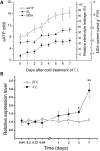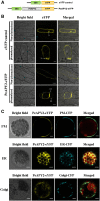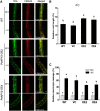Populus euphratica APYRASE2 Enhances Cold Tolerance by Modulating Vesicular Trafficking and Extracellular ATP in Arabidopsis Plants
- PMID: 26224801
- PMCID: PMC4577398
- DOI: 10.1104/pp.15.00581
Populus euphratica APYRASE2 Enhances Cold Tolerance by Modulating Vesicular Trafficking and Extracellular ATP in Arabidopsis Plants
Abstract
Apyrase and extracellular ATP play crucial roles in mediating plant growth and defense responses. In the cold-tolerant poplar, Populus euphratica, low temperatures up-regulate APYRASE2 (PeAPY2) expression in callus cells. We investigated the biochemical characteristics of PeAPY2 and its role in cold tolerance. We found that PeAPY2 predominantly localized to the plasma membrane, but punctate signals also appeared in the endoplasmic reticulum and Golgi apparatus. PeAPY2 exhibited broad substrate specificity, but it most efficiently hydrolyzed purine nucleotides, particularly ATP. PeAPY2 preferred Mg(2+) as a cofactor, and it was insensitive to various, specific ATPase inhibitors. When PeAPY2 was ectopically expressed in Arabidopsis (Arabidopsis thaliana), cold tolerance was enhanced, based on root growth measurements and survival rates. Moreover, under cold stress, PeAPY2-transgenic plants maintained plasma membrane integrity and showed reduced cold-elicited electrolyte leakage compared with wild-type plants. These responses probably resulted from efficient plasma membrane repair via vesicular trafficking. Indeed, transgenic plants showed accelerated endocytosis and exocytosis during cold stress and recovery. We found that low doses of extracellular ATP accelerated vesicular trafficking, but high extracellular ATP inhibited trafficking and reduced cell viability. Cold stress caused significant increases in root medium extracellular ATP. However, under these conditions, PeAPY2-transgenic lines showed greater control of extracellular ATP levels than wild-type plants. We conclude that Arabidopsis plants that overexpressed PeAPY2 could increase membrane repair by accelerating vesicular trafficking and hydrolyzing extracellular ATP to avoid excessive, cold-elicited ATP accumulation in the root medium and, thus, reduced ATP-induced inhibition of vesicular trafficking.
© 2015 American Society of Plant Biologists. All Rights Reserved.
Figures











Similar articles
-
Populus euphratica Apyrases Increase Drought Tolerance by Modulating Stomatal Aperture in Arabidopsis.Int J Mol Sci. 2021 Sep 13;22(18):9892. doi: 10.3390/ijms22189892. Int J Mol Sci. 2021. PMID: 34576057 Free PMC article.
-
Increased expression of OsSPX1 enhances cold/subfreezing tolerance in tobacco and Arabidopsis thaliana.Plant Biotechnol J. 2009 Aug;7(6):550-61. doi: 10.1111/j.1467-7652.2009.00423.x. Epub 2009 Jun 8. Plant Biotechnol J. 2009. PMID: 19508276
-
PpCBF3 from Cold-Tolerant Kentucky Bluegrass Involved in Freezing Tolerance Associated with Up-Regulation of Cold-Related Genes in Transgenic Arabidopsis thaliana.PLoS One. 2015 Jul 15;10(7):e0132928. doi: 10.1371/journal.pone.0132928. eCollection 2015. PLoS One. 2015. PMID: 26177510 Free PMC article.
-
Breakthroughs spotlighting roles for extracellular nucleotides and apyrases in stress responses and growth and development.Plant Sci. 2014 Aug;225:107-16. doi: 10.1016/j.plantsci.2014.06.002. Epub 2014 Jun 11. Plant Sci. 2014. PMID: 25017166 Review.
-
Role of Ca2+ in Mediating Plant Responses to Extracellular ATP and ADP.Int J Mol Sci. 2018 Nov 14;19(11):3590. doi: 10.3390/ijms19113590. Int J Mol Sci. 2018. PMID: 30441766 Free PMC article. Review.
Cited by
-
Extracellular ATP is involved in regulating Arabidopsis seed germination.Planta. 2022 Feb 13;255(3):66. doi: 10.1007/s00425-022-03839-w. Planta. 2022. PMID: 35152326
-
Comparative genomics and transcriptomics analysis reveals evolution patterns of selection in the Salix phylogeny.BMC Genomics. 2019 Mar 29;20(1):253. doi: 10.1186/s12864-019-5627-z. BMC Genomics. 2019. PMID: 30925896 Free PMC article.
-
UMP Kinase Regulates Chloroplast Development and Cold Response in Rice.Int J Mol Sci. 2019 Apr 29;20(9):2107. doi: 10.3390/ijms20092107. Int J Mol Sci. 2019. PMID: 31035645 Free PMC article.
-
Extracellular ATP promoted pollen germination and tube growth of Nicotiana tabacum through promoting K+ and Ca2+ absorption.Plant Reprod. 2018 Dec;31(4):399-410. doi: 10.1007/s00497-018-0341-6. Epub 2018 Jun 22. Plant Reprod. 2018. PMID: 29934740
-
P2K1 Receptor, Heterotrimeric Gα Protein and CNGC2/4 Are Involved in Extracellular ATP-Promoted Ion Influx in the Pollen of Arabidopsis thaliana.Plants (Basel). 2021 Aug 23;10(8):1743. doi: 10.3390/plants10081743. Plants (Basel). 2021. PMID: 34451790 Free PMC article.
References
-
- Bandmann V, Homann U (2012) Clathrin-independent endocytosis contributes to uptake of glucose into BY-2 protoplasts. Plant J 70: 578–584 - PubMed
-
- Bolte S, Talbot C, Boutte Y, Catrice O, Read ND, Satiat-Jeunemaitre B (2004) FM-dyes as experimental probes for dissecting vesicle trafficking in living plant cells. J Microsc 214: 159–173 - PubMed
-
- Borson ND, Salo WL, Drewes LR (1992) A lock-docking oligo(dT) primer for 5′ and 3′ RACE PCR. PCR Methods Appl 2: 144–148 - PubMed
Publication types
MeSH terms
Substances
LinkOut - more resources
Full Text Sources
Other Literature Sources

